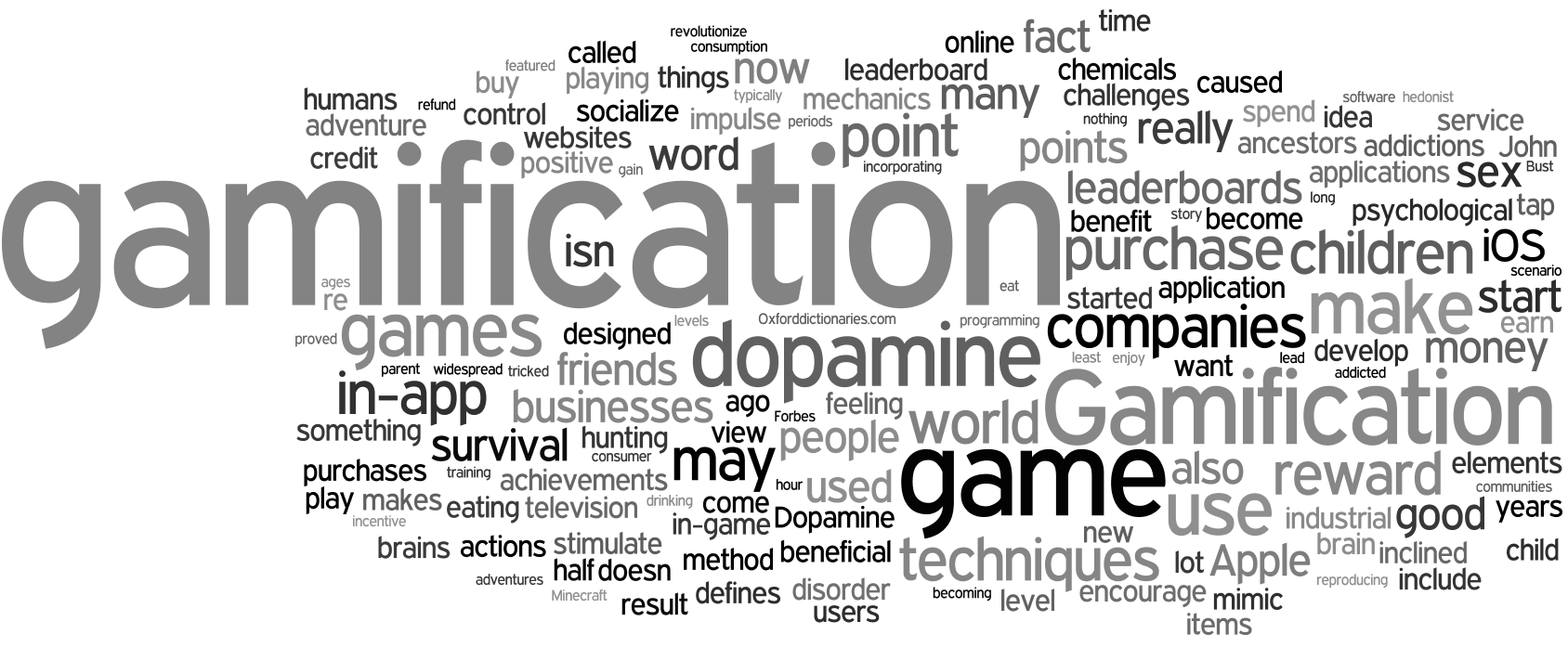If you have ever played a game or used a service simply to gain rewards, earn achievements, or level up, then you’ve taken part in something called “gamification.” Gamification is a method that businesses, websites, and games use to keep their users engaged for longer periods of time. In fact over 70% of Forbes Global 2000 companies plan to use at least one gamified application by 2014.

Gamifcation word cloud created at wordle.net
What is Gamification?
Gamification doesn’t only increase the time users spend on applications, but it can also give them an incentive to make a purchase, share a link, or do something beneficial for the company at hand. These techniques include points, badges, levels, leaderboards, challenges, bonuses, and many other incentives.
The general misconception about gamification is that it’s designed to mimic games, when in fact games are designed to mimic survival instincts. Gamification.org itself defines the word as:
- The use of game design techniques and game mechanics to solve problems and engage audiences
- Simply put, the term refers to incorporating game elements and mechanics into non-gaming websites and software.
Keep in mind that this is a relatively new idea. The word gamification isn’t even included in most dictionaries. Oxforddictionaries.com defines the word as
“The application of typical elements of game playing (e.g., point scoring, competition with others, rules of play) to other areas of activity, typically as an online marketing technique to encourage engagement with a product or service.”
While the word gamification may have a positive connotation, don’t be fooled by it, as you’re only getting half the story through the word “game.” Learn more about the idea behind gamification and arrive to your own conclusion about how it works and what its definition should be.
The Power Behind It
Our primate ancestors, Homo Erectus, were driven by chemicals which rewarded them for actions necessary for their survival. One of these main chemicals is called Dopamine. Dopamine is released in the brain to make you feel good when you eat, socialize, or reproduce so that you’re more inclined to do those things again.
“A preference for effortful consumption makes sense from an evolutionary point of view, for both animals and humans. If you are programming an animal to survive, you should make it enjoy more than just eating and drinking and having sex, which would encourage it to develop into nothing more than a couch potato or louche hedonist. You should make it love the activities that lead to the disocovery of food, water and sex. And that is what Dopamine does: it makes us want to repeat certain actions, be they hunting, going on dates or for that matter searching the screens for a trading opportunity” (John.)
Dopamine is also responsible for many addictions. Since people associate eating or reproducing with feeling good, they can start doing overdoing it to continue the good feeling. Drugs and sex addictions are fueled by the constant hunt for more Dopamine. So where does gamification come into play?

Photo by Nationaal Archief
Gamification techniques such as leaderboards tap into our human instinct to socialize. Just like our primitive ancestors socialized millions of years ago in their tightly-knit communities by showing off possessions and skills, we are inclined to do the same today through online leaderboards. Quests and challenges stimulate our brains in the same way that hunting and adventure would stimulate our ancestor’s brains. Gamification is actually a method of behaviorally training someone through the release of dopamine. While dopamine may have proved to benefit our survival in the past, it’s now being used against us through reward systems, motivational frameworks, and positive feedback loops to control our behaviors for the benefit of businesses.
Gamification in theory isn’t really a bad thing. Gamification used to apply to playing Chess or education systems but now it’s being applied in interestingly harmful ways: swipe your credit card in stores to earn “reward points,” tap the purchase button on your phone to buy in-app purchases, or spam your friends with app links to level up.
In a 2010 presentation by Jane McGoingal, a game designer, it was stated that players have spent a combined 5.98 billion years playing World of Warcraft. It’s only natural for businesses to realize the potential of gamification and bring it to their own applications. After all. Why have all of those people wasting their time playing video games when they could be buying your products or using your services?
The Downsides of Gamification in Our Society
When gamification increases for the commercial sector our productivity as humans may start to decrease. Do we really want to live in a world where children are addicted to spending money on valueless in-game items and memberships since the ages of 5 and up? Even a lot of adults have difficulty seeing why “reward points” for credit cards are not really beneficial, but rather harmful to you.
How will children fare against the gamification onslaught in the future? Gamification became popular in 2010 and has only had 3 years to mature. Imagine the effectiveness of it in a decade from now…
As we start adding on a “gamification layer” to our world our life will only get more complicated and stressful. The industrial boom a decade ago caused many people to experience neurasthenia. This is a “psychological disorder marked especially by easy fatigability and often by lack of motivation, feelings of inadequacy, and psychosomatic symptoms.” Then, when television came about everyone started watching action movies, adventures, and so forth. As a result people started becoming depressed about their own lives which featured none of the adventure.
That’s why it’s easier for children to disappear into a Minecraft or Call of Duty game than it is to practice basketball or spend half an hour calling up their friends to hang out. If the industrial revolution and television caused such a widespread disturbance in society, imagine what gamification will cause in the long run.
Apple’s Gamification Ecosystem
Apple’s game center is a minor form of gamification. It provides a leaderboards, connecting with friends, and achievements.
A lot of iOS games have in-app purchases now which basically allow you to “cheat” on games. These things may include anything from in-game coins to new items your character can use. Your dopamine brain is no match for logic, and even if it is: your child’s brain won’t be. They will associate spending money on those in-app purchases and characters with feeling happy, and in no time they will become addicted.
In fact Apple’s in-app purchase system has gone so out of control that it had to refund money to parents who had been affected by it. But the iOS gamification system doesn’t stop there. Private gamification companies such as Badgeville hope to not only revolutionize the effectiveness of gamification, but also corner the iOS market with their technology. While Apple may have their own morals and limits to gamification we can’t expect the same of 3rd party companies.
In a world where hundreds of companies are battling for a finite amount of consumers’ attention and money; it’s up to you where you have to draw the line. If you have young children who have been born into this commercial vs. consumer pull and tug, then it’s your responsibility as a parent that your child triumphs over them. Not educating children about the techniques companies use to make services/products irresistible could result in them become impulse buyers.
The worst case scenario is that childrens’ view of the world will become skewed or that they become psychological damaged. Not to the point where they will develop some mental disorder, but to the point where they are tricked by every reward program, leaderboard, or in-app purchase there is to waste time or money on.
Article written by Octavian Ristea.
Source used for quote: Coates, John. “The Speed of Thought.” The Hour between Dog and Wolf: Risk-taking, Gut Feelings and the Biology of Boom and Bust. New York: Penguin, 2012. N. pag. Print.